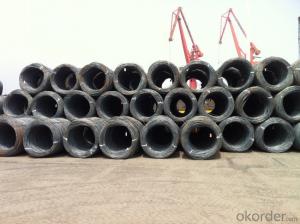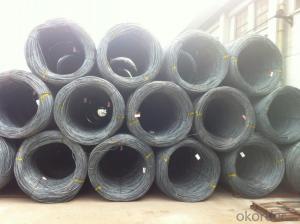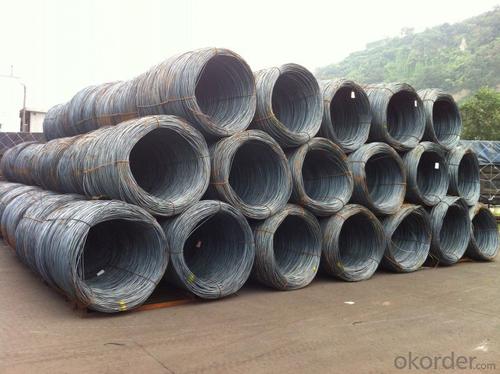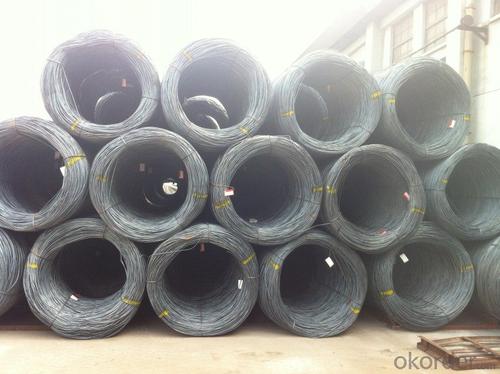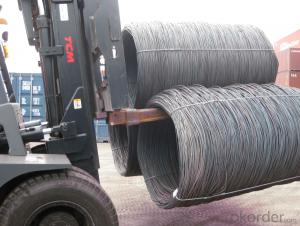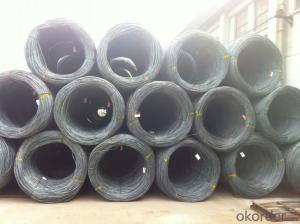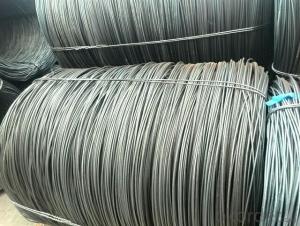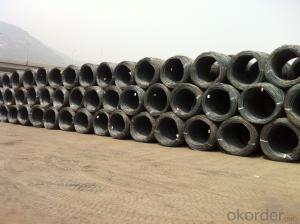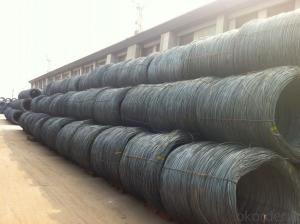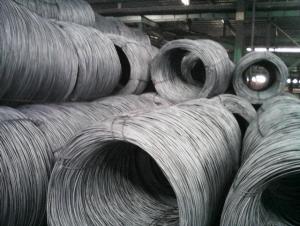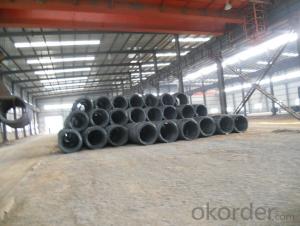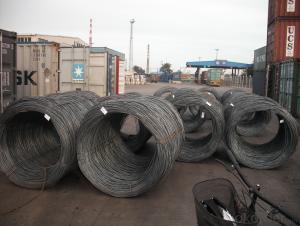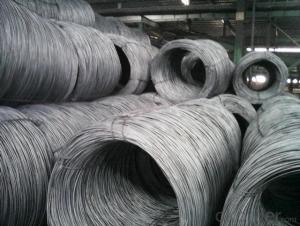Hot Rolled Wire Rods with Good Quality SAE 1008
- Loading Port:
- Tianjin
- Payment Terms:
- TT OR LC
- Min Order Qty:
- 25 m.t.
- Supply Capability:
- 10000 m.t./month
OKorder Service Pledge
OKorder Financial Service
You Might Also Like
Product Description:
OKorder is offering Carbon Steel Wire Rod at great prices with worldwide shipping. Our supplier is a world-class manufacturer of steel, with our products utilized the world over. OKorder annually supplies products to European, North American and Asian markets. We provide quotations within 24 hours of receiving an inquiry and guarantee competitive prices.
Product Applications:
Carbon Steel Wire Rod are ideal for structural applications and are widely used in the construction of buildings and bridges, and the manufacturing, petrochemical, and transportation industries.After hot-rolled the products shaped into coil and delivery as finished product, including round, square, rectangular, hexagonal and so on. Since most of the products are round, it is generally called wire rod. Carbon steel wire rod is widely used in construction and manufacturing. Carbon steel wire rod is mainly used for reinforcement of reinforced concrete and welded structure or reprocessed (roberts , nail, etc.) materials, especially used to produce wire drawing, welding electrode, nails, spring, electronic, precise machinery parts and so on.
Product Advantages:
OKorder's Carbon Steel Wire Rod are durable, strong, and resist corrosion.
Main Product Features:
· Premium quality
· Prompt delivery & seaworthy packing (30 days after receiving deposit)
· Corrosion resistance
· Can be recycled and reused
· Mill test certification
· Professional Service
· Competitive pricing
Product Specifications:
Chemical Composition:
Please kindly find our chemistry of our material based on SAE1006/SAE1008 as below for your information
Grade | Chemical Composition (%) | |||||
C | Mn | S | P | Si | B | |
SAE1006B | 0.03~O.07 | 0.32max | 0.045max | 0.040max | 0.30max | 0.0008min |
Mechanical properties | ||||||
Yield strength(N/mm2) | Tensile strength(N/mm2) | Elongation (%) | ||||
250-280 | 350-380 | ≥32 | ||||
Grade | Chemical Composition (%) | |||||
C | Mn | S | P | Si | B | |
SAE1008B | 0.10max | 0.3~0.50 | 0.050max | 0.040 max | 0.15max | 0.0008 min |
Mechanical properties | ||||||
Yield strength(N/mm2) | Tensile strength(N/mm2) | Elongation (%) | ||||
≥195 | 315-430 | ≥30 | ||||
FAQ:
Q1: Why buy Materials & Equipment from OKorder.com?
A1: All products offered byOKorder.com are carefully selected from China's most reliable manufacturing enterprises. Through its ISO certifications, OKorder.com adheres to the highest standards and a commitment to supply chain safety and customer satisfaction.
Q2: How do we guarantee the quality of our products?
A2: We have established an advanced quality management system which conducts strict quality tests at every step, from raw materials to the final product. At the same time, we provide extensive follow-up service assurances as required.
Q3: How soon can we receive the product after purchase?
A3: Within three days of placing an order, we will begin production. The specific shipping date is dependent upon international and government factors, but is typically 7 to 10 workdays.
Image
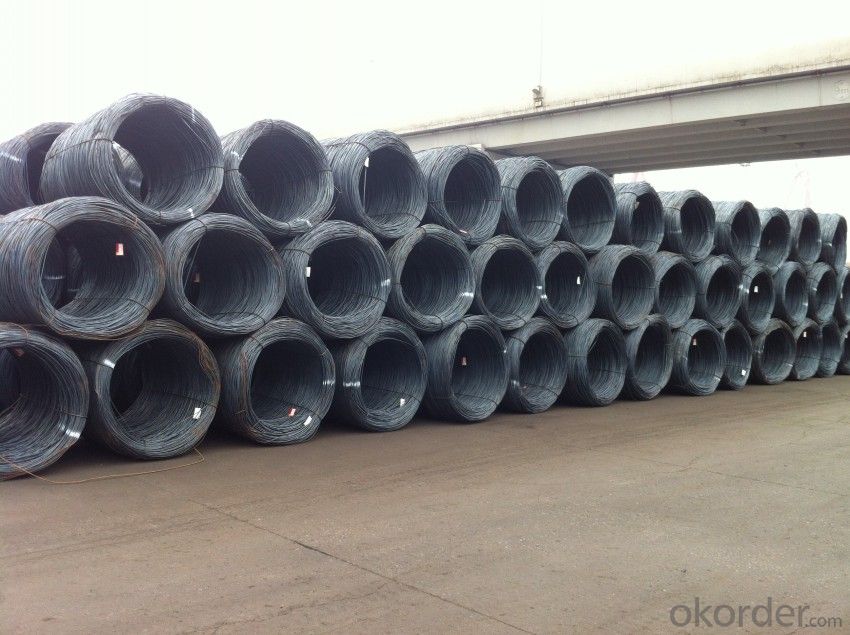
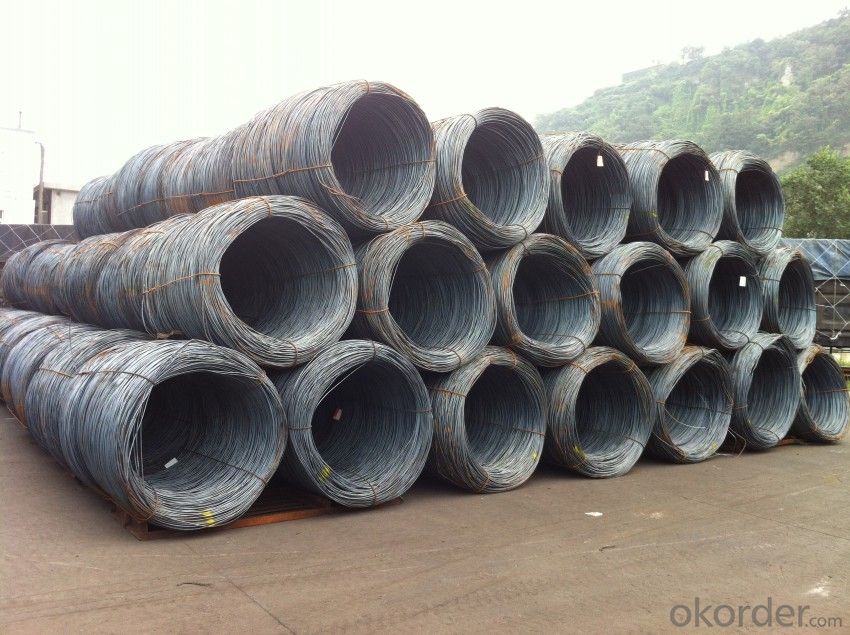
- Q: How does the magnetic properties of steel wire rod vary with different grades?
- The magnetic characteristics of steel wire rod can differ significantly depending on the grade. The magnetic behavior of steel primarily depends on its composition and microstructure, both of which can be modified in various ways to achieve different grades. Generally, steel wire rods with a higher carbon content tend to possess lower magnetic properties. This is because carbon atoms disrupt the alignment of the steel's magnetic domains, resulting in a decrease in overall magnetic strength. As a result, low carbon steel grades, like AISI 1006 or SAE J403 Grade 1006, typically display weaker magnetic properties. Conversely, steel wire rods containing higher levels of alloying elements, such as chromium, nickel, or manganese, usually exhibit enhanced magnetic strength. These alloying elements can affect the microstructure of the steel, promoting the formation of magnetic domains and improving magnetization overall. Stainless steel grades, which contain significant amounts of chromium and nickel, often demonstrate stronger magnetic properties compared to low carbon steel grades. It is important to note that while certain steel grades may inherently possess stronger or weaker magnetic properties, the specific manufacturing processes and heat treatments employed during the production of wire rods can also influence magnetic behavior. Different heat treatments can modify the microstructure and induce the precipitation of various phases in the steel, thereby impacting its magnetic properties. In conclusion, the magnetic properties of steel wire rod differ across various grades due to disparities in composition, alloying elements, and microstructure. Steel grades with higher carbon content generally exhibit weaker magnetic properties, while those with higher alloying elements tend to have increased magnetization. Additionally, the magnetic behavior of steel wire rod can also be affected by the specific manufacturing processes and heat treatments employed.
- Q: What are the different ductility testing methods for steel wire rod?
- There are several ductility testing methods available for steel wire rod. These methods are used to measure the ability of the material to deform under tensile stress without breaking. Some of the common ductility testing methods for steel wire rod include the following: 1. Tensile Test: This is the most common method used to assess the ductility of steel wire rods. In this test, a specimen of the wire rod is subjected to a gradually increasing tensile force until it breaks. The elongation and reduction in area of the specimen are measured, which provide valuable information about the ductility of the material. 2. Bend Test: This test involves bending a specimen of the wire rod to a specified angle without causing any cracks or fractures. The ability of the material to withstand bending without breaking indicates its ductility. The angle of bending and any visible defects are recorded to evaluate the ductility properties. 3. Cupping Test: This test is performed to determine the deep-drawing quality of steel wire rods. A specimen is placed over a die and a punch is used to deform it into a cup shape. The ability of the material to undergo deformation without cracking or tearing indicates its ductility. 4. Charpy Impact Test: While primarily used to measure the toughness of materials, the Charpy impact test is also indicative of the ductility of steel wire rods. In this test, a notched specimen is subjected to a high-velocity impact from a swinging pendulum. The energy absorbed during fracture is measured, and if the material exhibits high energy absorption, it suggests good ductility. 5. Fatigue Test: This test is used to assess the fatigue resistance of steel wire rods, which indirectly indicates their ductility. The specimen is subjected to repeated cyclic loading, and the number of cycles required for failure is recorded. A material with high ductility is expected to have better fatigue resistance. These testing methods provide valuable information about the ductility properties of steel wire rods, helping engineers and manufacturers select the appropriate material for specific applications.
- Q: What are the different surface marking methods for steel wire rod?
- Steel wire rods can be marked using various surface marking methods, each serving the purpose of identifying and providing information about the wire rod. One commonly used method involves hot stamping, which impresses an identification mark onto the surface of the wire rod using a heated stamp. This method is reliable and long-lasting since the mark becomes permanently engraved on the steel's surface. Another technique, inkjet printing, involves using an inkjet printer to directly print the necessary information onto the steel wire rod. This method is speedy and allows for flexibility in marking different types of information. Laser marking is also a popular choice, where a laser beam is utilized to remove or alter the surface material of the wire rod, leaving a permanent mark. This method offers precise and detailed markings. Moreover, embossing or engraving can be utilized to create raised or indented markings on the wire rod's surface. These methods are often employed for branding or decorative purposes, but can also convey important information about the wire rod. Ultimately, the selection of a surface marking method for steel wire rods depends on the manufacturer's specific requirements and preferences. Each method has its own advantages and limitations, necessitating careful consideration to ensure accurate and durable markings on the wire rods.
- Q: How is the straightness of steel wire rod measured?
- The measurement of the straightness of steel wire rod is typically done using a test known as the straightness deviation test. This test involves placing the rod on a flat surface and measuring the maximum distance between the rod and the surface at different points along its length. To conduct the test, a straightedge or a precision straightness measuring instrument is placed parallel to the steel wire rod on the surface. Multiple measurements are taken along the rod's length, usually at regular intervals. The distance between the rod and the straightedge is measured at each point, and the maximum deviation is recorded as the straightness deviation. The straightness deviation is commonly expressed as the maximum distance, in millimeters or inches, that the rod deviates from a completely straight line. A smaller deviation indicates a straighter rod, whereas a larger deviation implies a more bent or curved rod. Besides the straightness deviation test, other methods like visual inspection or laser technology can also be utilized to evaluate the straightness of steel wire rod. These alternative methods offer a more detailed and accurate measurement of the rod's straightness, enabling manufacturers to ensure that the rod meets the required quality standards for its intended application.
- Q: What are the major players in the steel wire rod industry?
- Some of the major players in the steel wire rod industry include ArcelorMittal, Nippon Steel Corporation, POSCO, Tata Steel, and Baosteel Group. These companies are globally recognized for their significant market shares and strong presence in the steel wire rod market.
- Q: How is steel wire rod used in the manufacturing of wire forms for automotive cooling systems?
- Due to its excellent strength and durability properties, steel wire rod is commonly utilized in the production of wire forms for automotive cooling systems. These wire forms are crucial components that provide structural support and help maintain the desired shape and functionality of various cooling system parts. One notable application of steel wire rod in automotive cooling systems is seen in the manufacturing of radiator cores. Radiator cores consist of a network of small tubes and fins that efficiently transfer heat from the engine coolant to the surrounding air. These tubes and fins are often connected and supported by wire forms made from steel wire rod. Steel wire rod is chosen for this purpose due to its high tensile strength, enabling the wire forms to withstand the pressure and vibration experienced in automotive cooling systems. Additionally, steel wire rod exhibits excellent resistance to corrosion, ensuring the wire forms' longevity and reliability even in harsh operating conditions. In the manufacturing process, steel wire rod is initially shaped using specialized machinery. Subsequently, the wire undergoes various heat treatment procedures to enhance its strength and flexibility. Once the wire forms are fabricated, they are integrated into the radiator core assembly, providing support and stability to the tubes and fins. Furthermore, steel wire rod finds use in the production of other wire forms such as hose clamps, brackets, and hooks in automotive cooling systems. These wire forms play vital roles in securing hoses, connecting components, and providing structural support to ensure the proper functioning of the cooling system. Overall, steel wire rod is an indispensable material in the manufacturing of wire forms for automotive cooling systems. Its strength, durability, and corrosion resistance make it an ideal choice for supporting and maintaining the integrity of various cooling system components, ultimately contributing to the efficient operation of the automotive cooling system.
- Q: What are the different types of steel wire rod surface cleaning methods for wire galvanizing flux?
- There are several types of steel wire rod surface cleaning methods used for wire galvanizing flux. These include mechanical cleaning methods such as abrasive blasting or shot blasting, chemical cleaning methods like pickling or acid cleaning, and electrolytic cleaning methods. Each method has its own advantages and suitability depending on the specific requirements and condition of the steel wire rod.
- Q: How is the quality of steel wire rod assessed?
- The quality of steel wire rod is assessed through various parameters such as chemical composition, mechanical properties, surface defects, and dimensional accuracy. These assessments are typically performed by conducting tests and inspections, such as chemical analysis, tensile strength testing, visual inspection, and measurement checks. Additionally, industry standards and specifications are used as benchmarks to ensure that the steel wire rod meets the required quality standards.
- Q: How is steel wire rod classified based on its diameter?
- Steel wire rod is classified based on its diameter into different size ranges, commonly referred to as gauges or wire sizes. These sizes can vary depending on the industry or manufacturing standards being followed.
- Q: What are the common industry qualifications for steel wire rod professionals?
- Common industry qualifications for steel wire rod professionals can vary depending on the specific role and level of expertise required. However, some of the common qualifications include a degree or certification in materials science, metallurgy, or mechanical engineering. Additionally, specialized certifications such as Certified Welding Inspector (CWI) or Certified Materials Professional (CMP) can also be beneficial in demonstrating expertise in the field. Experience working with steel wire rod production processes and knowledge of industry standards and regulations are also highly valued qualifications.
Send your message to us
Hot Rolled Wire Rods with Good Quality SAE 1008
- Loading Port:
- Tianjin
- Payment Terms:
- TT OR LC
- Min Order Qty:
- 25 m.t.
- Supply Capability:
- 10000 m.t./month
OKorder Service Pledge
OKorder Financial Service
Similar products
Hot products
Hot Searches
Related keywords

